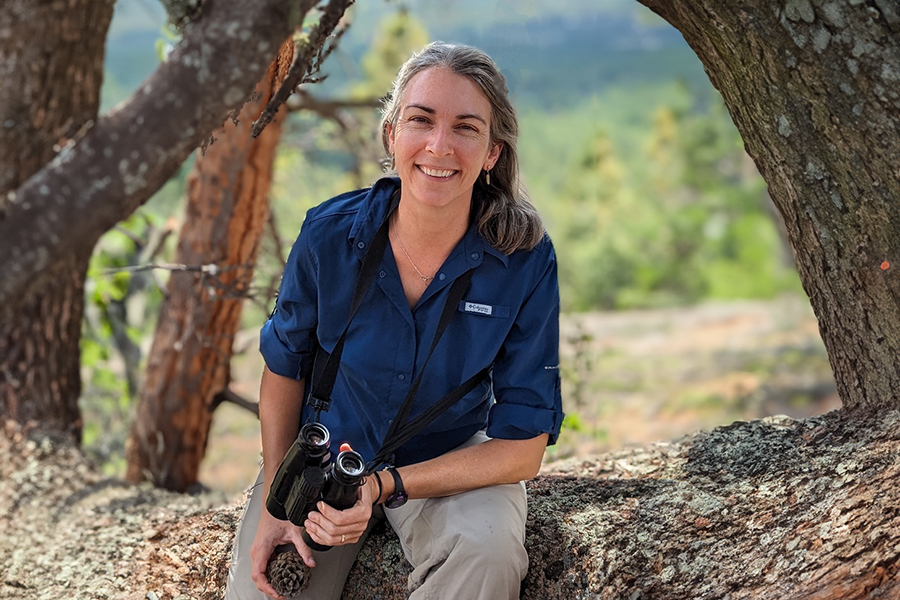FSU biologist earns American Ornithological Society Award for research challenging accepted mate selection theory

A Florida State University ornithologist has received a prestigious award for resolving a mismatch between accepted theory and the observed behavior of female birds when choosing mates.
Professor of Biological Science Emily DuVal is the recipient of the 2024 Katma Award from the American Ornithological Society (AOS) for her paper, “Inferred Attractiveness: A Generalized Mechanism for Sexual Selection that can Maintain Variation in Traits and Preferences Over Time,” published in the journal PLOS Biology. The inferred attractiveness hypothesis suggests that younger females observe and emulate the mate choices of more experienced females without necessarily understanding why.
“I am so honored to have won the Katma Award,” DuVal said. “It allows this paper to reach a broader audience, and I look forward to others considering the implications of our ideas and evaluating them in a variety of organisms.”
“Inferred Attractiveness” was co-authored by Courtney Fitzpatrick of Texas A&M University, Elizabeth Hobson of the University of Cincinnati and Maria Servedio of the University of North Carolina at Chapel Hill.
As the world’s largest ornithological society, AOS is a global network of professionals working to advance the scientific study and conservation of birds. AOS was established in 2016 through the merger of the American Ornithologists’ Union and the Cooper Ornithological Society, founded in 1883 and 1893, respectively.
“The Katma Award is given for innovation and research that brings a fresh perspective on old scientific theories,” said Thomas Houpt, chair of the Department of Biological Science. “This recognition helps cement the department’s reputation for world-class field work combined with world-class theory.”
Many nature documentaries capture the elaborate and colorful displays of male birds attempting to attract a mate, suggesting that females tend to choose the flashiest male. However, researchers who study animals’ mate choices rarely find such patterns. Much of DuVal’s research has centered on lance-tailed manakins — a small neotropical bird species — and a set of female lance-tailed manakins that observe the same males but make different choices.
Other examples include peacocks, whose mate preferences vary among populations, northern cardinals, whose females may shun the vibrant red coloring of males in favor of courtship behaviors such as allofeeding, when males use a beak-to-beak method of feeding seeds to females.
“The inferred attractiveness hypothesis was inspired in part by situations where predictions based in widely accepted theory did not match up with what I observed in the wild for my own studies,” DuVal said. “Our hypothesis generates some of the same patterns predicted by other mate choice models, but with a much simpler mechanism underlying the seemingly complex behavior.”
DuVal suggests that young female birds use context clues to learn, correctly or incorrectly, what traits make a male attractive. For instance, if a young female bird concludes that an older female chose a mate based on his song, she will choose a mate with a similar song. This happens regardless of whether the older female made her selection for that reason.
“Science is a team sport, and this paper was a truly rewarding group effort,” DuVal said. “My lab members — both grads and undergrads — made major contributions to the paper’s development. They read the manuscript drafts and thoughtfully considered interpretations of our results as my coauthors, and I were grappling with them ourselves.”
DuVal and her coauthors plan to test key parts of the hypothesis with data from animals’ behavior in controlled choice trials, which connects to DuVal’s usual research focus: collecting information about individual animals’ lives to support answers for bigger conceptual questions in behavioral ecology.
“The idea that social information influences mate choices are not new,” DuVal said. “In fact, it is an important factor in many organisms from fruit flies to humans, but the twist here is exploring what happens when females infer what makes a male stand out, rather than having a clear understanding why a choice is made.”
To learn more about DuVal’s research and FSU’s Department of Biological Science, visit bio.fsu.edu.

